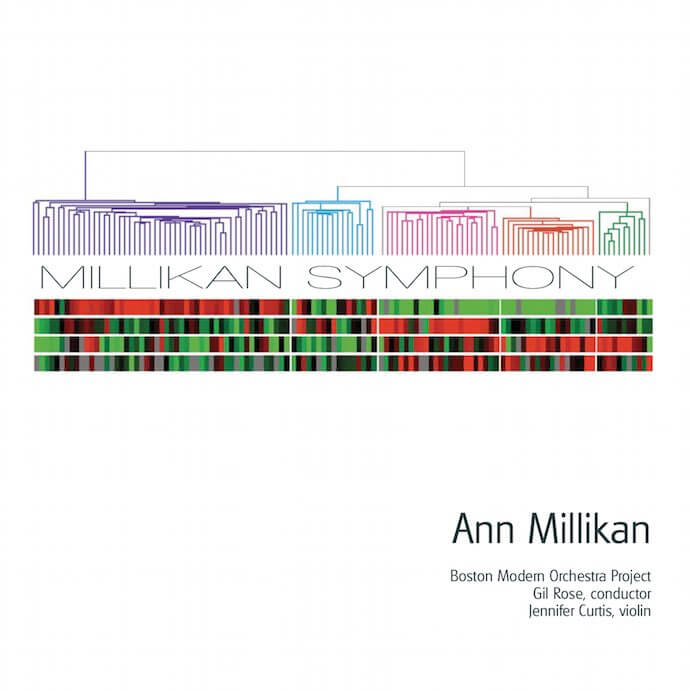Ann Millikan’s imaginative and moving Millikan Symphony is an elegy to her brother, Robert C. Millikan, who died in 2012. As Sarah Cahill explains in her remarkable liner notes for the 2017 Innova recording from Boston Modern Orchestra Project and violin soloist Jennifer Curtis, each of the four movements reflects an essential quality of Millikan’s memories of her brother, “Science,” “Animals,” “Rowing,” and “Violin.”
Dr. Robert C. Millikan was a cancer epidemiologist and researcher who specialized in breast cancer and genetic mutation. The first movement of Millikan Symphony, “Science,” is an extended metaphor for the subject of her brother’s research: the genetic processes of cancer growth. The movement is a musical explanation of cancer taking over the body, a clear, well-explained, and utterly intelligible musical understanding. Two conceptual characters drive the movement: the person (a complex set of co-occurrent processes and interactions) and the cancer (a parasitic error inside the person that mutates, replicates, and ultimately metastasizes into all parts of the person). All of the symphony’s traditional musical materials—instrument family groups, pacing, melodic contour, even cadences—engage to illustrate these two characters so clearly that the listener does not struggle to hear the contrast between the functioning person and the cancer that activates and spreads.
Ann Millikan
The cancer begins as short motifs, pitch contours that spread throughout the family groups, and in themselves do not present as troubling or sinister. The chillingly logical effect comes into focus as orchestra whirls headlong into the onslaught, the cancer expanding and extrapolating across the workings of the entire symphony. The movement recalls another masterful use of sound to explain genetic replication: Radiolab’s incredible aural explanation of the CRISPR/Cas9 gene editing technology in their 2015 podcast, “Antibodies Part 1: CRISPR.” Scientists frequently use the symphony as a metaphor to explain the living body, a system of complex interactions between simultaneous functions. It is fascinating to hear the inverse: the symphony itself creates and performs the metaphor of the functioning body, even as it fails.
“Animals” is a warbling pastoral that recalls both Dr. Millikan’s early days as a veterinarian and his Fulbright year in Ireland. Sweet, folksy appoggiaturas in the piccolo solo and wandering string melodies recall the preciousness of our pets, the tender cherishing we feel towards animal companions. The melodic contours in the solo lines rise and fall evenly, sculpting a balanced landscape over a sleepy cloud of dissonance with graceful satisfactions of every expectation. A surprising direct quotation from the Mendelssohn Violin Concerto punctuates the reverie, which Cahill’s liner notes bring to light with the story of Dr. Millikan practicing violin in his veterinary clinic. Though the movement evokes Irish memories, there is still a fresh Americanness to Millikan’s symphonic writing, a sense of wide natural expanse in her long lines and warm, saturated ensemble sound.
The third movement, “Rowing,” is written at 6 minutes, 11 seconds, to precisely correspond with an actual rowing race from the 2013 Millikan Cup in real time. The movement begins with orchestra members shouting the race countdown, then bursting out to push and pull in coordinated effort. The movement shows Millikan has an incredible ability to illustrate and spark the imagination–the music reflects the rhythms of agitation as the rowers push their bodies athletically, the pinches of dissonance as the lungs and legs begin to burn, and the rotations of oars and dragging water. The orchestra works in persistently duple and cyclic rotation, up-down, push-pull, until the final 20 seconds when the effort is done, the finish line crossed, and tired euphoria sets in.
Jennifer Curtis
The symphony closes with “Violin,” a complete miniature violin concerto in a single movement, written from a motif that Dr. Robert Millikan wrote himself as a young violinist and composer. The concerto is both childlike and complex, perfectly capturing the spirit of a passionate young player in almost-singable rich melodies, soaring upper-register passages, and virtuosic violin acrobatics. In one striking moment, Millikan explores the persistence of memory as the violin soloist leaves notes from her melody lingering on in the violin section, a suspended echo effect. The “third movement,” so to speak, is engagingly asymmetrical, swinging into sudden stops and jump cuts. The coda begins very traditionally, with an exciting stretto gradual build toward a final cadence, but surprises further when the bottom drops out only to rebuild again in a new direction. In this movement, solo violinist Jennifer Curtis is particularly on display, and she approaches the devilishly awkward exposed passages with incredible daring. Her tone quality is sparkling, remarkably even across the range of the instrument, and overtone-dense, perfect for Millikan’s writing in characteristically violinistic styles ranging from showpiece bravura to longingly vocalistic.
Sarah Cahill notes that Millikan Symphony is remarkable for its “spirit of collaboration,” and extols Ann Millikan’s efforts to find experts among her brother’s friends and colleagues during her research for each of the four movements. The fruits of her research are audible: Millikan Symphony is simultaneously deeply felt and deeply considered. The work is truly a symphonic understanding, not just of Dr. Millikan’s research and personal interests, but of the multiple ways of knowing— and remembering— a beloved person’s life. The listening experience will be incomplete without some further collaboration on the part of the listener, to reach out and engage with the themes that weave through Ann Millikan’s remembrance of her brother. To fully understand the elegy in Millikan’s music, the listener must take some time to learn about Dr. Millikan’s life and consider how his family, friends, colleagues, and students might remember him after his passing.

